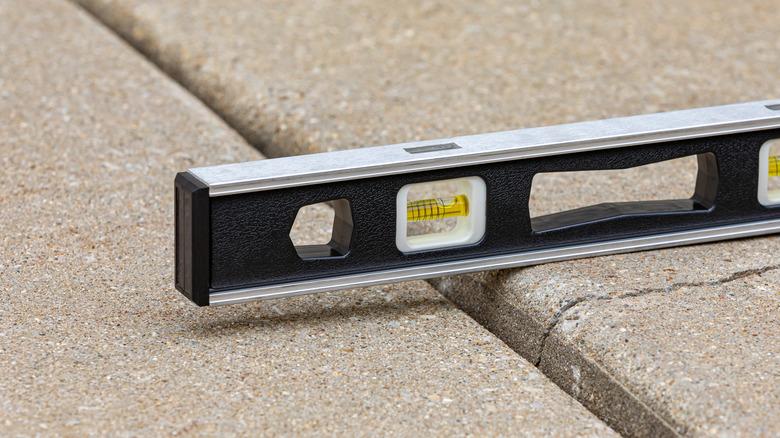Repairing Cracks In Concrete? Avoid These Common Mistakes At All Costs
It's easy to stand in your garage, perhaps marveling at your hot water recirculation system or the web of cables entering your electrical load center, and forget that the bit of concrete you're standing on is also surprisingly complicated. Which means things can go wrong, leading to repairs that are also complicated and can go amiss. To get a handle on the mistakes people make when repairing concrete, Hunker spoke exclusively with Frontdoor Virtual Handyperson Expert Brett Labeka, who walked us through what goes wrong, and how to avoid trouble.
When repairing a cracking concrete garage floor, driveway, slab, or foundation cracks, Labeka explained, it could be the result of many possible causes. It's important to understand which you're dealing with so you know how to do the repair properly and if it's possible to repair it yourself. "Concrete cracks can form due to various reasons," Labeka said, "including stresses exceeding the materials strength, shrinkage, temperature fluctuations, overloading, corrosion of reinforcement, and chemical reactions." Shrinkage, settlement, thermal, and corrosion cracks can be related to specific problems. Those include moisture loss, uneven settling, temperature changes, and corrosion of metal reinforcements. You can address many of these yourself. But you might need a professional's help if you have cracks that are actively moving or changing; cracks larger than ½ inch wide; severely uneven cracks; signs of structural issues; or cracks that involve metal corrosion.
"Most people believe that simply filling the crack will permanently fix the problem," Labeka said. "The crack is usually a symptom, not just cosmetic damage. It cracked because of underlying stressors, like movement, settling, thermal expansion/contraction, shrinkage, poor original mix, or even moisture issues."
Common mistakes when repairing concrete
There are three types of mistakes that homeowners commonly make when trying to repair cracks in their concrete. When Hunker spoke exclusively with Frontdoor expert handyperson Brett Labeka, he broke it down as improper surface prep, using the wrong materials, and not allowing for harsh environmental conditions or not allowing enough curing time for repair materials. Preparing the concrete surface for repair is simple enough. "Concrete repair materials need a clean and rough surface to bond properly," he said. The other common mistakes are more challenging to get a handle on.
Choosing a concrete repair product isn't as straightforward as it seems. "Not all crack fillers are the same," Labeka said. "It's important to do your research and ensure you are choosing a quality product." That usually means seeking out epoxy-based fillers, he said, explaining that they "offer excellent adhesion and durability – ideal for both structural and cosmetic cracks or repairs. They also cure quickly and can be used in a variety of crack widths and depths." But there are many types of "caulk" for concrete, and minor cracks can be dealt with using latex-based fillers, and you can use polyurethane to repair cracks that are burdened with lots of traffic or exposure to extreme weather.
Harsh weather also factors into proper concrete curing time, which is crucial to avoiding concrete cracks. "Temperature, moisture, and time matter when repairing cracks in concrete," Labeka said. "Curing times can vary depending on the type of product being used and the environmental conditions (temperature, humidity) where the project is located."
Doing concrete repairs right
Filling a crack in concrete usually sounds simple. How complicated could it possibly be to squeeze in a tube of concrete repair filler? But the tricks to getting it right lie in understanding the type of cracking you have and which filler is called for, using the filler correctly, and handling the repair in a way that minimizes the negative effects of extreme temperatures or temperature fluctuations. You will often need to widen the crack, expert handyperson Brett Labeka told Hunker exclusively, then clean the area and use a bonding agent before filling it in. "Hairline cracks, structural cracks, and expansion joints each require different products," he said.
While simple hairline cracks can be handled using a simple concrete crack filler, more troublesome concrete cracks need a slightly different approach. "Structural cracks require epoxy injections," Labeka said, "however, you may need to consult a structural engineer for more severe or larger structural cracks." And expansion cracks, including those that are wider or are in motion, will require a flexible sealant like silicone.
These are general guidelines, he added, noting that you should always follow the manufacturer's package directions when it comes to when and how to use a concrete repair material. "Check that the temperature is within the product's recommended range (usually above 50 degrees F)," Labeka said. "Shade the repair from direct sunlight, and mist with water or cover with plastic to retain water." Be careful not to put weight or stress on the repaired area until you've allowed the cure time recommended by the manufacturer, he added.


